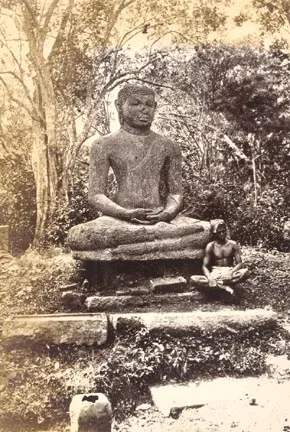
Lying between the gigantic Abhayagiriya Stupa and the Kuttam Pokuna (Twin Ponds) belonging to the ancient Abhayagiri Monastery, Samadhi Statue is considered one of the greatest works of sculptural art of the early period of Anuradhapura era. It is thought to be done during the 3rd or the 4th century. It is made out of dolomite marble and stands 7 feet 3 inches (2.21 meters) in height. This statue was found in the present location in 1886 fallen to the ground with damages to the nose. It was then erected and the nose was reconstructed unsuccessfully. In 1914, it was found damaged by treasure hunters and re constructed again which still was eye sore.
The statue’s eyes are hollow indicating they were impressed with crystal or precious stones. When this area was excavated it was clear that this was one of 4 statues placed around the Bodhi tree growing here. During excations in 1960 the Bodhighara (Bodhi tree) was discovered including a Asanagala and a Sri Pathul gala. Of the 4 seated images, the one facing north has survived. There are few fragments of another one on the pedestal facing South. It is quite possible that the other two had been removed to another temple at a later date.

The Samadhi Statute is carved from a single rock. A thin body hugging robe without any visible folds covering only the left folder is carved from the rock. The right leg lies over the left leg with foot palms facing upwards in the Veerasana Posture. There is no urna roma at the forehead of the Buddha but the hair is carved in snail like curls.
It is said that when you look at the face of the statue from three sides they show 3 different features. Looking at the profile of the face from left and right they show a slight sadness and a slightly smiling face on the other. Looking from the front, the face shows neutral features.

Today this stature is covered by concrete structure which has somewhat destroyed the beauty of this statue. Even the reconstruction of the nose has not been a success which looks very artificial.
Next to the Samadhi statue is an ruins of an image house which is called Bodhisattva Image House. According to Maha Vamsa, the great chronicle of Sri Lanka, it is said that the King Dhatusena (459-477) has built an image house for the Maithree Bodhisattva left to the Abhayagiriya Bodhi Tree Shrine and had decorated with royal garments. It is believed these remains are the image house built by king Dhatusena. An limestone Bodhisattva image has been found buried in the rubble which has been dated to the 5th century.
References
• Seneviratna, A., 1994. Ancient Anuradhapura. 1st ed. Colombo: Archaeological Survey Department, Sri Lanka.